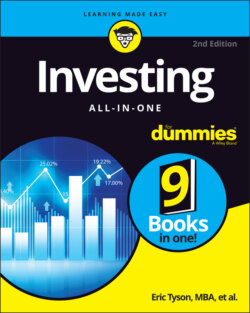Читать книгу Investing All-in-One For Dummies - Eric Tyson - Страница 56
Exploring the role of the Federal Reserve
ОглавлениеWhen the chairman of the Federal Reserve Board speaks (currently, it’s Jerome Powell; before him, it was Janet Yellen; and before her, it was Ben Bernanke), an extraordinary number of people listen. Most financial market watchers and the media want to know what the Federal Reserve has decided to do about monetary policy. The Federal Reserve is the central bank of the United States. The Federal Reserve Board comprises the 12 presidents from the respective Federal Reserve district banks and the 7 Federal Reserve governors, including the chairman who conducts the Federal Open Market Committee meetings behind closed doors eight times a year.
What exactly is the Fed (as it’s known), and what does it do? The Federal Reserve sets monetary policy. In other words, the Fed influences interest-rate levels and the amount of money or currency in circulation, known as the money supply, in an attempt to maintain a stable rate of inflation and growth in the U.S. economy.
Buying money is no different from buying lettuce, computers, or sneakers. All these products and goods cost you dollars when you buy them. The cost of money is the interest rate that you must pay to borrow it. And the cost or interest rate of money is determined by many factors that ultimately influence the supply of and demand for money.
The Fed, from time to time and in different ways, attempts to influence the supply of and demand for money and the cost of money. To this end, the Fed raises or lowers short-term interest rates, primarily by buying and selling U.S. Treasury bills on the open market. Through this trading activity, known as open market operations, the Fed is able to target the Federal funds rate — the rate at which banks borrow from one another overnight.
The senior officials at the Fed readily admit that the economy is quite complex and affected by many things, so it’s difficult to predict where the economy is heading. If forecasting and influencing markets are such difficult undertakings, why does the Fed exist? Well, the Fed officials believe that they can have a positive influence in creating a healthy overall economic environment — one in which inflation is low and growth proceeds at a modest pace.
Over the years, the Fed has come under attack for various reasons. Various pundits accused former Fed Chairman Alan Greenspan of causing speculative bubbles, such as the boom in technology stock prices in the late 1990s or in housing in the early 2000s. Some economists have argued that the Federal Reserve has, at times, goosed the economy by loosening up on the money supply, which leads to a growth spurt in the economy and a booming stock market, just in time to make El Presidente look good prior to an election. Conveniently, the consequences of inflation take longer to show up — they’re not evident until after the election. In recent years, others have questioned the Fed’s ability to largely do what it wants without accountability.
Many factors influence the course of stock prices. Never, ever make a trade or investment based on what someone at the Federal Reserve says or what someone in the media or some market pundit reads into the Fed chairman’s comments. You need to make your investment plans based on your needs and goals, not what the Fed does or doesn’t do.
